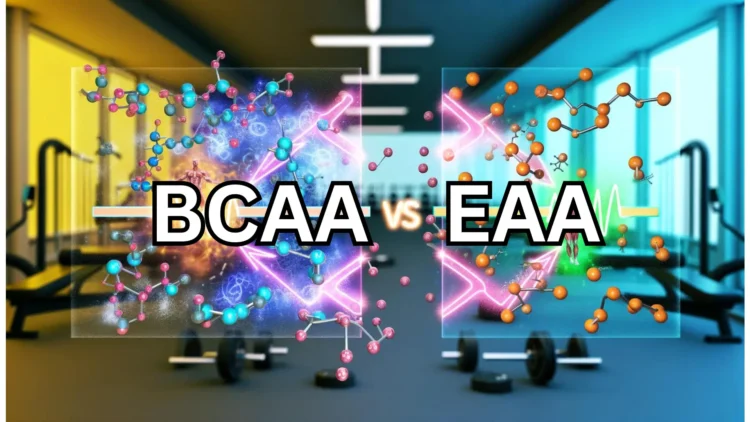Did you know that amino acids are the building blocks of protein and play a crucial role in muscle building and performance?
If you are on a quest to optimize your fitness routine, it’s essential to understand the differences between two popular amino acid supplements: BCAAs and EAAs.
These supplements have gained significant attention in the bodybuilding and fitness community for their potential benefits in supporting muscle growth and enhancing workout performance.
BCAAs, or branched-chain amino acids, are a subset of essential amino acids that include valine, leucine, and isoleucine. These amino acids are metabolized directly in the muscles, making them a popular choice among athletes.
On the other hand, EAAs, or essential amino acids, consist of eight amino acids that the body cannot produce on its own. These amino acids are crucial for protein biosynthesis and are involved in various physiological processes.
In this article, we will delve deep into the benefits, differences, and effectiveness of BCAAs and EAAs. Whether you’re a bodybuilder, athlete, or fitness enthusiast, understanding the best amino acid supplement for your goals can make a world of difference in your training results.
So, let’s unravel the mysteries behind BCAAs and EAAs and determine which one is better suited for muscle building and performance.
Key Takeaways:
- BCAAs and EAAs are two popular amino acid supplements that aid in muscle building and performance.
- BCAAs consist of three essential amino acids—valine, leucine, and isoleucine—and are metabolized directly in the muscles.
- EAAs contain eight essential amino acids that the body cannot produce on its own and play a crucial role in protein biosynthesis.
- Understanding the differences and benefits of BCAAs and EAAs can help optimize your fitness routine and training results.
- Consulting with a healthcare professional or nutritionist is recommended to determine the best supplementation strategy for your specific needs.
The Basics: Why EAA and BCAA are indispensable for your training
When it comes to optimizing your training and maximizing your results, essential amino acids (EAAs) and branched-chain amino acids (BCAAs) are two crucial components that cannot be overlooked.
These amino acid complexes play a vital role in protein biosynthesis and are essential for your body’s overall performance and muscle-building capabilities.
EAA and BCAA are both composed of essential amino acids that are not naturally produced by the body. These amino acids are necessary for protein biosynthesis, which is the process by which the body builds and repairs muscle tissue.
Without an adequate supply of essential amino acids, the body can experience nutritional deficiencies, leading to muscle weakness and other detrimental effects.
Essential amino acids can be found in animal and plant protein-rich foods. Animal protein sources such as meat, eggs, and dairy products are particularly rich in essential amino acids, making them an excellent choice for meeting your body’s protein needs.
However, it can sometimes be challenging to consume enough animal protein to provide all the essential amino acids your body requires for optimal performance and muscle synthesis.
Here is where EAA and BCAA supplements come in. By taking these supplements, you can ensure that your body is receiving an adequate supply of essential amino acids, even if your daily diet falls short.
EAA and BCAA supplements can help overcome nutritional deficiencies and provide your body with the necessary building blocks for muscle growth, recovery, and overall performance.
By incorporating EAA and BCAA supplements into your training routine, you can optimize muscle protein synthesis and enhance your body’s ability to build and repair muscle tissue. This, in turn, can lead to improved athletic performance, increased muscle strength, and faster recovery between workouts.
In the next sections, we will delve deeper into the specifics of EAAs and BCAAs, exploring the benefits, differences, and effects of these essential amino acid complexes on muscle building and workout performance.
EAAs: The essential amino acids for your body
Essential amino acids (EAAs) are vital for the body’s protein-building processes and maintaining the health of our muscle tissue.
These amino acids, including valine, leucine, isoleucine, lysine, methionine, phenylalanine, tryptophan, and threonine, cannot be produced by the body and must be obtained through diet or supplementation. EAAs serve as the building blocks for protein synthesis, which is essential for muscle growth, repair, and maintenance.
Muscle weakness and other negative effects can occur when there is a deficiency of these essential amino acids. Without an adequate supply of EAAs, the body may struggle to build and repair muscle tissue, leading to decreased muscle strength and function.
Given the importance of EAAs in muscle development, many athletes and fitness enthusiasts rely on EAA supplementation to ensure they have a sufficient supply of these essential protein building blocks.
By providing the body with the necessary EAAs, supplementation can help optimize muscle growth, enhance overall athletic performance, and prevent muscle weakness and degradation.

| EAA | Function | Sources |
|---|---|---|
| Valine | Supports muscle metabolism and tissue repair | Poultry, dairy products, beans, nuts |
| Leucine | Stimulates muscle protein synthesis and aids in recovery | Meat, dairy products, legumes, lentils |
| Isoleucine | Assists in energy production and muscle tissue repair | Meat, fish, eggs, soybeans, nuts |
| Lysine | Plays a role in collagen production and muscle tissue maintenance | Meat, fish, dairy products, tofu |
| Methionine | Aids in the synthesis of proteins and other important compounds | Poultry, fish, dairy products, legumes |
| Phenylalanine | Functions as a precursor for important neurotransmitters | Meat, fish, eggs, dairy products, legumes |
| Tryptophan | Supports serotonin production and plays a role in mood regulation | Poultry, fish, eggs, dairy products, tofu |
| Threonine | Essential for collagen, elastin, and muscle tissue formation | Poultry, fish, dairy products, lentils |
Including a variety of protein-rich foods in your diet can help ensure an adequate intake of these EAAs. However, for those who struggle to meet their EAA requirements through food alone, EAA supplementation can be a convenient and effective solution.
Quote:
“EAAs are the fundamental building blocks for muscle growth and repair, making them essential for athletes and fitness enthusiasts seeking to optimize their performance.”
BCAAs: How it supports your body and muscles
BCAAs, which stands for branched-chain amino acids, are a group of three essential amino acids: valine, leucine, and isoleucine. These amino acids play a crucial role in supporting muscle metabolism and aiding muscle recovery.
Unlike other amino acids that are metabolized in the liver, BCAAs are directly metabolized in the muscles, making them readily available for energy production and muscle synthesis.
BCAAs are particularly popular among athletes and fitness enthusiasts as a dietary supplement due to their numerous benefits. Let’s take a closer look at how BCAAs support your body and muscles:
Sustaining Muscle Metabolism
BCAAs are known to promote muscle protein synthesis, which is essential for building and maintaining muscle mass. Leucine, in particular, plays a key role in triggering the mTOR pathway, a signaling pathway that regulates muscle protein synthesis.
By providing a direct source of amino acids for the muscles, BCAAs help sustain muscle metabolism, allowing for optimal muscle growth and repair.
Preventing Muscle Degradation
During intense exercise or periods of calorie restriction, the body may enter a catabolic state where it breaks down muscle tissue for energy. BCAAs can help prevent muscle degradation by providing the necessary amino acids to fuel energy production.
Studies have shown that supplementing with BCAAs, especially leucine, can help preserve muscle mass and prevent muscle breakdown, particularly during prolonged endurance activities or low-calorie diets.
Aiding in Muscle Recovery
After a strenuous workout, muscle tissue undergoes microscopic damage, leading to muscle soreness and fatigue. BCAAs can help enhance muscle recovery by promoting protein synthesis and reducing muscle inflammation.
By providing the building blocks for muscle repair, BCAAs aid in the recovery process, allowing for faster healing, reduced muscle soreness, and improved overall muscle function.
As a result of their unique metabolism and muscle-supporting properties, BCAAs have become a staple in the fitness industry. Athletes engaged in intense training and workouts can benefit greatly from incorporating BCAA supplementation into their nutrition regimen.
Next, we’ll explore the differences between EAAs and BCAAs and determine which amino acid complex delivers better results for muscle building and workout performance.
EAAs vs. BCAAs: Which amino acids deliver the better results?
The debate over EAAs vs. BCAAs continues, as both amino acid complexes have their own advantages. Essential amino acids (EAAs) and branched-chain amino acids (BCAAs) are both crucial for muscle protein synthesis and muscle building.
However, the presence of all eight essential amino acids in EAAs makes them the rate-limiting factor for muscle hypertrophy. BCAAs, on the other hand, play a key role in triggering the mTOR pathway and promoting muscle protein synthesis.
The role of EAAs in muscle building
Essential amino acids are the building blocks of proteins in the body, and they play a crucial role in muscle protein synthesis. The combination of all eight essential amino acids found in EAAs provides a complete profile of amino acids needed for muscle building and optimal performance. These amino acids are:
- Lysine
- Isoleucine
- Leucine
- Methionine
- Phenylalanine
- Threonine
- Tryptophan
- Valine
EAAs ensure that your body has an adequate supply of all essential amino acids required for protein synthesis and muscle tissue repair. This comprehensive profile of amino acids makes EAAs an excellent choice for those looking to maximize muscle hypertrophy and overall muscle building.
The role of BCAAs in muscle building
BCAAs, on the other hand, consist of three essential amino acids: valine, leucine, and isoleucine. These amino acids are unique because they are metabolized directly in the muscles rather than in the liver.
BCAAs are known for their muscle-sparing properties, preventing muscle degradation during intense workouts and aiding in muscle recovery.
Additionally, leucine, one of the three BCAAs, plays a crucial role in triggering the mTOR pathway, which is essential for muscle protein synthesis. By activating this pathway, BCAAs promote muscle protein synthesis and support muscle building.
While BCAAs have their benefits in terms of muscle recovery and protein synthesis, their limited profile of essential amino acids compared to EAAs makes them less effective as a rate-limiting factor for muscle hypertrophy.

| Aspect | EAAs | BCAAs |
|---|---|---|
| Amino acids included | All 8 essential amino acids | 3 essential amino acids |
| Role in muscle protein synthesis | Supports muscle protein synthesis as rate-limiting factor | Activates mTOR pathway, promotes muscle protein synthesis |
| Muscle building effectiveness | Highly effective for muscle hypertrophy and muscle building | Supports muscle recovery and protein synthesis but less effective as rate-limiting factor |
Based on the table above and the role of each amino acid complex, it can be concluded that EAAs offer a more comprehensive and effective approach to muscle building and muscle hypertrophy.
While BCAAs have their benefits in terms of muscle recovery and protein synthesis, the inclusion of all essential amino acids in EAAs makes them the preferred choice for maximizing muscle growth and overall muscle building.
Strength or endurance workout: What do you need for which workout?
When it comes to optimizing your workout performance, understanding the right amino acid intake is crucial. Depending on whether you engage in strength training or endurance sports, the choice between BCAAs and EAAs can make a significant difference in supporting your fitness goals.
Strength Training: For individuals focused on strength and muscle building, EAAs are highly recommended. These supplements contain all eight essential amino acids, providing your body with the necessary building blocks to promote muscle growth and repair.
Endurance Sports: On the other hand, if you’re participating in endurance sports or cardio training, BCAAs may suffice. These supplements contain the essential amino acids required for energy production and muscle recovery, which are crucial for prolonged endurance activities.
It’s important to note that individual preferences and responses to amino acid supplementation can vary. Some individuals may find that combining BCAAs and EAAs works best for their specific needs. Experimentation and personalization are key in determining the optimal amino acid intake for your workouts.
Benefits of EAAs for Strength Training:
“EAAs provide all eight essential amino acids required for muscle building and repair, making them an ideal choice for those engaged in strength training. By supplying your body with a comprehensive profile of amino acids, EAAs support protein synthesis and contribute to muscle hypertrophy.”
Benefits of BCAAs for Endurance Sports:
“BCAAs, with their energy-producing properties and ability to aid muscle recovery, are valuable supplements for individuals involved in endurance sports. These amino acids not only provide fuel for sustained physical activity but also help reduce muscle damage and fatigue, ultimately improving performance.”
While the choice between BCAAs and EAAs largely depends on the specific demands of your workout routine, it’s essential to prioritize proper nutrition and supplementation to optimize your performance and achieve your fitness goals.
| Branched-Chain Amino Acids (BCAAs) | Essential Amino Acids (EAAs) | |
|---|---|---|
| Composition | Contain three essential amino acids: valine, leucine, and isoleucine. | Comprise all eight essential amino acids: valine, leucine, isoleucine, lysine, methionine, phenylalanine, tryptophan, and threonine. |
| Benefits | – Energy production – Muscle recovery – Muscle-sparing properties |
– Muscle building and repair – Protein synthesis support – Comprehensive amino acid profile |
| Suitable For | Endurance sports and cardio training | Strength training and muscle building |
Conclusion
In conclusion, both BCAAs and EAAs are essential for muscle building and improving workout performance.
EAAs provide all eight essential amino acids necessary for protein synthesis and muscle tissue repair, making them a comprehensive option for supporting muscle growth.
BCAAs, on the other hand, are known for their ability to preserve muscle mass during intense workouts and prevent muscle degradation.
When it comes to choosing between BCAAs and EAAs, it ultimately depends on individual preferences, training goals, and dietary habits. Some individuals may benefit more from EAAs, as they provide a complete profile of essential amino acids.
Others may find BCAAs sufficient for their needs, especially if they are looking to preserve muscle mass and prevent muscle breakdown during exercise.
It is important to note that supplementation should be personalized and tailored to individual needs. Consulting with a healthcare professional or a nutritionist can help determine the best supplementation strategy based on your specific goals and requirements.
By incorporating the right amino acid supplementation into your fitness routine, you can optimize muscle building, enhance workout performance, and achieve the results you desire.
FAQ
What are BCAAs and EAAs?
BCAAs (branched-chain amino acids) and EAAs (essential amino acids) are complexes of essential amino acids that the body cannot produce on its own. They are necessary for protein biosynthesis and muscle building.
What are the benefits of taking BCAAs and EAAs?
Taking BCAAs and EAAs can help overcome nutritional deficiencies, support muscle metabolism, prevent muscle degradation during exercise, aid in muscle recovery, and promote muscle protein synthesis.
What is the difference between EAAs and BCAAs?
EAAs contain all eight essential amino acids, while BCAAs contain three essential amino acids. EAAs play a crucial role in muscle protein synthesis and muscle building, while BCAAs are popular for their muscle-sparing properties during intense workouts.
Which is better for muscle building and performance, BCAAs or EAAs?
Both BCAAs and EAAs have their benefits. EAAs, with their complete profile of essential amino acids, are considered the rate-limiting factor for muscle hypertrophy. However, the choice depends on individual preferences, training goals, and dietary habits.
When should I take EAAs and BCAAs?
For strength training, it is recommended to take EAAs, while BCAAs may be sufficient for endurance sports or cardio training. However, individual responses can vary, so it’s best to experiment and find the option that works best for your specific needs.
Do I need to consult a healthcare professional or nutritionist before taking BCAAs or EAAs?
It is always advisable to consult with a healthcare professional or nutritionist before starting any supplementation strategy to determine the best approach for your specific needs and ensure it aligns with your overall health and wellness goals.








